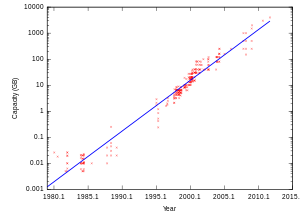- Mark Kryder
-
Mark Kryder (b. October 7, 1943 in Portland, Oregon) was Seagate Corp.'s senior vice president of research and chief technology officer.[1]
Kryder holds a Bachelor of Science degree in Electrical Engineering from Stanford University and a Ph.D. in Electrical Engineering and Physics from the California Institute of Technology.[1]
Contents
Kryder's Law
A 2005 Scientific American article, drawing from Moore's law, says that magnetic disk areal storage density doubles annually, a phenomenon that had come to be known as Kryder's Law.[2]
In 2005, commodity drive density of 110 gigabit/in2 or 170 megabit/mm2 had been reached. This does not extrapolate all the way back to the initial 2 kilobit/in2 drives introduced in 1956, as growth rates increased with the advent of institutionalized strategic technology re-investment such as the MTC (Magnetics Technology Center later the Data Storage Systems Center).[2][3]
A PhysOrg.com article reports on a 2009 study by Mark Kryder.[4] According to the report, if hard drives continue to progress at their current pace, then in 2020 a two-platter, 2.5-inch disk drive will be capable of storing more than 14 terabytes(TB) and will cost about $40. It also investigates 13 up-and-coming non-volatile memory technologies to see whether one of them might outperform hard drives on a cost-per-TB basis in 2020.
Awards and honors
Mark H. Kryder is an elected member of the National Academy of Engineering, a Fellow of the American Physical Society and a Fellow of the Institute of Electrical and Electronic Engineers (IEEE).[1] He was Distinguished Lecturer for the IEEE Magnetics Society, and has been awarded the IEEE Magnetics Society Achievement Award and IEEE Reynold B. Johnson Information Storage Systems Award.[5] Kryder received the Pingat Bakti Masyarakat[6] from Singapore in their 2007 National Day Awards.
References
- ^ a b c "2007 George E. Pake Prize Recipient". American Physical Society. 2007. http://www.aps.org/programs/honors/prizes/prizerecipient.cfm?name=Mark%20Kryder&year=2007.
- ^ a b Walter, Chip (August 2005). "Kryder's Law". Scientific American. http://www.scientificamerican.com/article.cfm?id=kryders-law.
- ^ Sadik C. Esener; Mark H. Kryder, et al (June 1999). "The Future of Data Storage Technologies" (PDF). International Technology Research Institute. p. 85. http://www.wtec.org/pdf/hdmem.pdf. Retrieved 16 October 2011.
- ^ Kryder, Mark H.; Chang Soo Kim (October 2009). "After Hard Drives - What Comes Next?" (PDF). IEEE Transactions on Magnetics 45 (10). doi:10.1109/TMAG.2009.2024163. http://www.dssc.ece.cmu.edu/research/pdfs/After_Hard_Drives.pdf. Lay summary – PhysOrg.com (October 2009).
- ^ Nyenhuis, John; Richard Dee (eds) (August 2000). "Kryder Receives IEEE Reynold B. Johnson Information Storage Award". IEEE Magnetics Society Newsletter. http://www.ieeemagnetics.org/Newsletter/August00/index.html.
- ^ "2007 Public Service Medal". Pingat Bakti Masyarakat (PMB). Archived from the original on 2008-02-07. http://web.archive.org/web/20080207173113/http://www.pmo.gov.sg/PMOHQ/NDA/2007/ThePublicServiceMedal/Page4.htm.
External links
- "Kryder's Law". MattsComputerTrends.com. http://www.mattscomputertrends.com/Kryder's.html.
- "Kryder's Law @ Scientific American". Seagate. http://www.seagate.com/ww/v/index.jsp?locale=en-US&name=Kryders_Law_&vgnextoid=6ad295e4bba0e010VgnVCM100000dd04090aRCRD.
- Kozierok, Charles M. (2001-04-17). "A Brief History of the Hard Disk Drive". http://www.pcguide.com/ref/hdd/hist-c.html.
- "Mark Kryder, Carnegie Mellon University". http://www.ece.cmu.edu/directory/details/91.
Categories:- Computer hardware engineers
- Living people
- IBM employees
- Fellow Members of the IEEE
- Stanford University alumni
- Members of the United States National Academy of Engineering
- 1943 births
Wikimedia Foundation. 2010.

